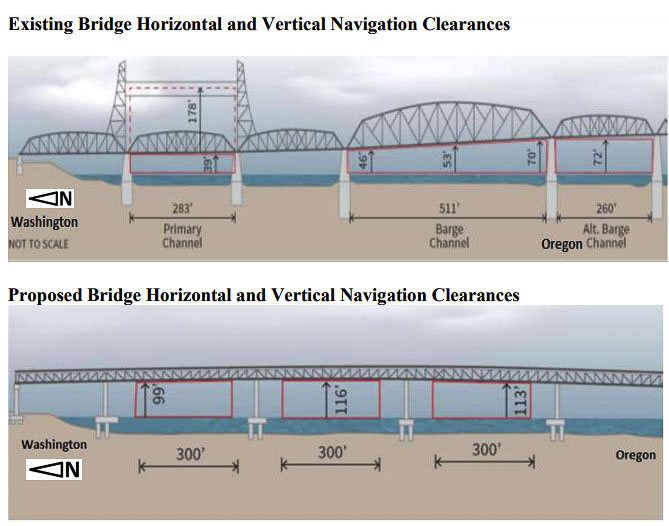Significant reduction in Columbia River vertical navigation clearances at issue
The Interstate Bridge Replacement (IBR) team is seeking permission to build a bridge offering 32 percent less clearance for Columbia River marine traffic, than the current bridge offers. The U.S. Coast Guard has given people a chance to offer formal comments until next week about their needs for vertical and horizontal clearances on the river.
In March, the Seattle office of the U.S. Coast Guard filed notice that it has received a request from the IBR team to design a bridge offering 116 feet of clearance above the Columbia River. Citizens and interested maritime users have been given until April 25 to submit comments that will be considered in the process.
In November 2020, the IBR team was told it would need to obtain a new permit. The previous permit had expired, and had been the topic of considerable controversy for allowing “a bridge too low.”
“This Public Notice (PN) is soliciting for comments exclusively related to navigation. Maritime transportation system stakeholders (vessels and facilities) are highly encouraged to carefully review this notice and provide comments with regard to the proposed bridge’s ability to meet the needs of navigation to include mariner requirements for horizontal navigation clearances and vertical navigation clearances,”

The Coast Guard noted the current proposal includes a fixed bridge with “a significant (32 percent) reduction in vertical navigation clearances” compared to what the existing two bridge structures offer.
In the previous effort, the request was denied because the Columbia River Crossing (CRC) project team failed to provide documentation showing the 95-foot clearance “will meet reasonable navigation requirements” according to a December 2011 letter. CRC officials later tried with 110-foot clearance. The Coast Guard was not able to approve the bridge permit application. It said it may require the project to supplement the Federal Environmental Impact Statement (FEIS) in order to accept an application.
The CRC ultimately received approval for a structure with 116 feet of clearance. But that approval required payment of $86.4 million in “mitigation” to three up river firms that were harmed. Adjusted for inflation, that would cost taxpayers at least $106 million today.
The Coast Guard specifically asks:
Mariners and maritime stakeholders are requested to express their views, in writing, on the proposed bridge and its possible impact on navigation, if any, giving sufficient detail to establish a clear understanding of their reasons for support of, or opposition to, the proposed work. To include but not limited to mariner’s requirements for horizontal navigation clearances and vertical navigation clearances to include air draft and air gap requirements. The Coast Guard is particularly interested in receiving comments from maritime stakeholders with vertical navigation clearance requirements of greater than 116 feet.
“Our needs for navigation clearance have not changed since the original survey by CRC,” John Rudi told Clark County Today. He’s CEO of Thompson Metal Fab. “Obviously, a static bridge that meets the needs of Thompson, as far as navigation clearance, is an unrealistic option. The additional costs of a larger structure and impacts of extended touchdowns on each side of the river, as well as Hayden Island and surrounding communities would be significant.”
Two other companies are next to Thompson, each constructing similar large-scale fabrications. Greenberry Industrial, of Corvallis, leased space in 2010 and Oregon Iron Works occupies 7.5 acres. The fabricators ship on the river only a handful of times a year. But their cargoes are often too large to clear the 95-foot span originally proposed over a decade ago. That required “mitigation” with the 116-foot former CRC proposal.
In June of 2013, two of the firms reached an agreement to be paid “mitigation” in order to allow the project to move forward. A couple months later, the final agreement would have paid a reported $86.4 million to the three firms, with nearly $50 million going to Thompson.
Rudi said at the time, Thompson planned to build a second “satellite” facility downstream of the new bridge, from which it would ship its largest products. Thompson hoped to keep all of its operations in Clark County.
For further information on the IBR project please refer to the following link: https://www.interstatebridge.org/
Comments will be received for the record at the office of: Commander (dpw), Thirteenth
Coast Guard District, 915 2nd Ave, Rm 3510, Seattle, WA or via email at mailto: D13-SMBD13-BRIDGES@USCG.MIL. Comments should be sent to arrive on or before April 25, 2022.
This news report from November 2020 highlights when the US Coast Guard told the IBR team members they would need to get a new permit. Many river users have to call for a bridge lift due to the fast moving water current and the need to do the “S curve” to safely navigate the BNSF rail bridge one mile west.




